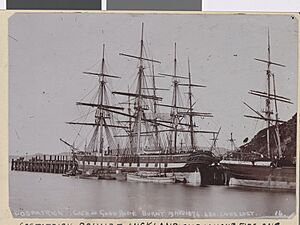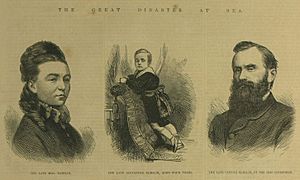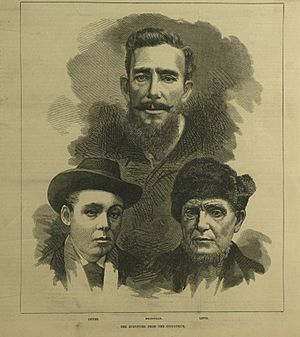Cospatrick (ship) facts for kids

The Cospatrick - The Graphic 9 Jan. 1875, from a photograph taken just before she sailed from Gravesend
|
|
Quick facts for kids History |
|
|---|---|
| Name | Cospatrick |
| Acquired | 1862 by Smith, Fleming & Co. |
| Commissioned | 1856 |
| Fate | Destroyed by fire south of Cape of Good Hope in 1874 |
| General characteristics | |
| Class and type | Blackwall Frigate |
| Tonnage | 1,199 GRT |
| Length | 191 ft (58 m) |
| Beam | 34 ft (10 m) |
| Depth of hold | 23 ft 6 in (7.2 m) |
| Propulsion | Sail |
| Sail plan | full-rigged ship |
| Complement | 44 |
The Cospatrick was a large wooden sailing ship with three masts. It caught fire south of the Cape of Good Hope on November 18, 1874. The ship was on a long journey from Gravesend, England, to Auckland, New Zealand. Out of 472 people on board, only three survived this terrible event. It is often called one of the worst disasters in New Zealand's history.
Contents
The Cospatrick Ship's History
The Cospatrick was a type of ship called a Blackwall Frigate. It was built in 1856 in Moulmein (now Mawlamyain) in Burma. The ship was built for a famous London ship owner named Duncan Dunbar.
After Dunbar passed away in 1862, Smith, Fleming & Co. of London bought the ship. For most of its life, the Cospatrick sailed between England and India. It carried passengers, soldiers, and goods.
In 1863, the Cospatrick helped lay a telegraph cable in the Persian Gulf. This was an important job for communication. The ship also made two trips to Australia. In 1873, the Cospatrick was sold to Shaw, Savill & Co. of London. This company used many ships like the Cospatrick to carry goods and people moving from England to New Zealand.
The Fire and Loss of the Ship
The Cospatrick left Gravesend for Auckland on September 11, 1874. There were 433 passengers and 44 crew members on board. Most of the passengers were people moving to New Zealand, including 125 women and 126 children. During the trip, eight babies died, and one baby was born.
The journey was mostly calm until November 18. Around 12:45 a.m., a fire suddenly started. This was about 12 hours after the ship's location was known to be 400 nautical miles (740 km) southwest of the Cape of Good Hope.
Henry Macdonald, the ship's second mate, said he heard a cry of "Fire!" He rushed to the deck and saw flames in the boatswain's (ship's officer's) storage area. This area held things like oakum (loose fibers), tar, paint, and ropes, which are all very flammable.
The crew tried to put out the fire with hoses. The Captain and crew also tried to turn the ship. They hoped this would make the smoke and flames blow forward and help control the fire. But they could not do it.
The fire quickly grew out of control, and people began to panic. The ship had five lifeboats that could hold 187 people. However, only two of these boats were successfully launched into the water.
The two lifeboats stayed together for a few days. But on the night of November 21, one boat disappeared during a storm. On November 27, another ship called the British Sceptre found the remaining lifeboat. By then, only five men were still alive. They had drifted about 500 nautical miles (930 km) northeast from where the Cospatrick had sunk. Sadly, two of these five survivors died soon after they were rescued.
What Happened After the Disaster
An investigation was held to find out why the fire started. It was most likely caused by someone using an open flame near flammable materials in the ship's cargo area. Things like tar, oil, and paint were stored there. Another idea was that the fire started by itself, which is called spontaneous combustion.
People were very upset that so few lifeboats were launched successfully. But not much changed until after the sinking of the Titanic in 1912. That disaster finally led to new rules for ship safety and lifeboats.
See also
- List of disasters in New Zealand by death toll
- HMS Orpheus (1860)




